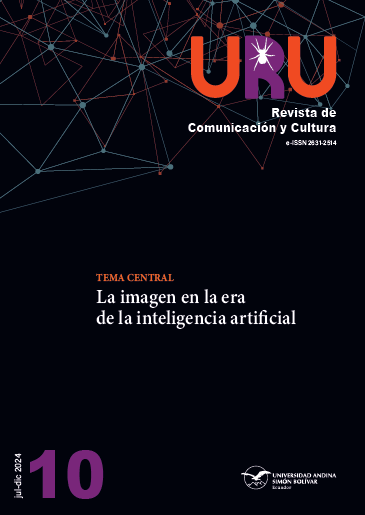Artificial Intelligence and the Transformation of Artistic Expressions
DOI:
https://doi.org/10.32719/26312514.2024.10.4Keywords:
Artificial intelligence, artistic expressions, cultural transformation, creativity, ethics, technology, generative art, cultural diversityAbstract
This scientific article explores the intersection between Artificial Intelligence (AI) and artistic expressions, analyzing their transformation within the cultural context. It examines how AI has impacted the production and appreciation of art in various disciplines such as painting, music, literature, among others. Technological advancements enabling AI to generate creative works are discussed, along with the ethical and social challenges posed by this coexistence between human creativity and art generation by algorithms. These challenges include questioning the authenticity of produced art and addressing disparities in technology access.
Downloads
References
Ars Technica. 2016. “Sunspring | A Sci-Fi Short Film Starring Thomas Middleditch”. Video de YouTube. 9 de junio. https://tinyurl.com/3nyh8bxu.
Boden, Margaret. 1990. The Creative Mind: Myths and Mechanisms. Londres: Routledge.
Brianza, Alejandro. 2024. “Audiovisión e inteligencia artificial”. Alejandro Brianza. Accedido 12 de junio. https://tinyurl.com/2k52e5xf.
Jorge. 2019. Contra Amazon. Barcelona: Galaxia Gutenberg. https://tinyurl.com/5ar4js6c.
Cope, David. 1989. “Experiments in Musical Intelligence (EMI): Non?Linear Linguistic?Based Composition”. Interface 18 (1-2): 117-39. https://doi.org/10.1080/09298218908570541. DOI: https://doi.org/10.1080/09298218908570541
—. 1991. Computer Models of Musical Creativity. Cambridge, US: The MIT Press.
De Propios, Cristina. 2022. “Arte e inteligencia artificial: Técnicas de aprendizaje automático en el arte generativo actual”. Tesis doctoral, Universidad Complutense de Madrid, España. https://tinyurl. com/2s39epau.
DW. 2018. “Cuadro creado por algoritmo es subastado por 432.600 dólares”. DW. 26 de octubre. https://tinyurl.com/yz638naf.
Franco, Miriam, Mario Romero, Manuel Palmoar, José Ángel Cobos, Giaan Álvarez y Daniel Hernández. 2024. “De neuronas biológicas a neuronas artificiales, el fascinante mundo de las redes neuronales”. Universidad Autónoma del Estado de Hidalgo. https://tinyurl.com/mupasdve.
García, Chris. 2015. “Algorithmic Music: David Cope and EMI”. Computer History Museum. 29 de abril. https://tinyurl.com/y3t8ayua.
—. 2016. “Harold Cohen and AARON: A 40-Year Collaboration”. Computer History Museum. 23 de agosto. https://tinyurl.com/4stexj28.
Gatys, Leon, Alexander Ecker y Matthias Bethge. 2015. “A Neural Algorithm of Artistic Style”. ArXiv. 2 de septiembre. https://tinyurl.com/2p9hp9s4.
Granados, Jackeline. 2022. “Análisis de la inteligencia artificial en las relaciones laborales”. Revista CES Derecho 13 (1): 111-32. https://tinyurl.com/bd7harnj. DOI: https://doi.org/10.21615/cesder.6395
Jiménez, Silvia. 2018. “Generación y evaluación de secuencias melódicas mediante inteligencia artificial”. Proyecto de fin de carrera, Universidad Politécnica de Madrid, España. https://tinyurl.com/5vv95h6x.
Jonas, Hans. 1995. El principio de responsabilidad: Ensayo de una ética para la civilización tecnológica. Barcelona: Herder.
Justo, David. 2018. “Subastan por primera vez un retrato creado por una inteligencia artificial”. Cadena Ser. 26 de octubre. https://tinyurl.com/5n7yvpmh.
Luz, Bibiana, y Lucía Malbernat. 2021. “Riesgos, dilemas éticos y buenas prácticas en inteligencia artificial”. Ponencia presentada en el XXIII Workshop de Investigadores en Ciencias de La Computación (WICC 2021), Chilecito, abril. https://tinyurl.com/2p9feny8.
Miranda, Alfonso. 2020. “Inteligencia artificial demasiado humana (aún): Arte y tecnología”. Revista Digital Universitaria 21 (1). http://doi.org/10.22201/codeic.16076079e.2020.v21n1.a7. DOI: https://doi.org/10.22201/codeic.16076079e.2020.v21n1.a7
Noble, Safiya. 2018. Algorithms of Oppression: How Search Engines Reinforce Racism. Nueva York: New York University Press. DOI: https://doi.org/10.2307/j.ctt1pwt9w5
Rodríguez, Nuria. 2020. Inteligencia artificial y campo del arte. Málaga, ES: Universidad de Málaga.
Saiz, Concepción. 2019. “Las obras creadas por sistemas de inteligencia artificial y su protección por el derecho de autor”. InDret 1. https://tinyurl.com/yca77y76.
Sheer Uncertainty. 2016. “Benjamin LSTM RNN”. Medium. 2 de agosto. https://tinyurl.com/3nxdtk44.
Studio Wayne McGregor. 2024. “Cuando la tecnología conoció a Wayne McGregor”. Google Arts & Culture. Accedido 12 de junio. https://tinyurl.com/f9yhwr84.
Valero, Angelo. 2022. “Creación de música clásica con deep learning”. Tesis de ingeniería, Universidad de los Andes, Colombia. https://tinyurl.com/486v2a5n.
Published
How to Cite
Issue
Section
License
Copyright (c) 2024 Uru: Revista de Comunicación y Cultura

This work is licensed under a Creative Commons Attribution-NonCommercial-ShareAlike 4.0 International License.
ASSIGNMENT OF RIGHTS, DECLARATION OF CONFLICT OF INTEREST AND DISSEMINATION
The authors who publish in this journal accept the following conditions:
- Authors retain copyright and grant the journal the right of first publication, with the work registered under the Creative Commons Attribution-NonCommercial-ShareAlike 4.0 License, which allows sharing, adapting and attributing the work (see: Open Access Policies).
- Authors can make other independent and additional contractual agreements for the distribution of the article published in this journal (e.g., include it in an institutional repository or publish it in a book) as long as they expressly indicate that the article was published for the first time in Uru: Revista de Comunicación y Cultura. In the case of reproduction, a note similar to the following must be included: This text was originally published in the journal Uru: Revista de Comunicación y Cultura N ° -, year of publication.
- Authors are encouraged to publish their work on the Internet (e.g. on institutional or personal pages) in the final version published by Uru: Revista de Comunicaicón y Cultura as it may lead to a wider and faster dissemination of the published work.








